The Italian government has announced a press campaign to retrieve the famous Victorious Youth statue from California’s Getty Museum. In addition, a resolution by Italy’s senate advocates retooling legal education to give cultural heritage law prominence, as well as establishing a new pool of magistrates to focus on cultural heritage cases.
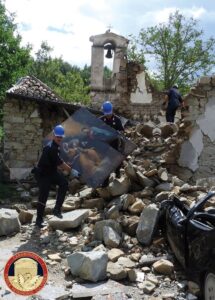
The Italian Carabinieri Department for the Protection of Cultural Heritage -TPC, rescuing a painting after a series of four major earthquakes struck Central Italy between Abruzzo, Lazio, the Marche and Umbria regions in January 2017, UNESCO, 15 June 2017, CCA-SA 3.0 IGO license.
Meanwhile, with far less fanfare, Italy’s Carabinieri TPC have pursued behind-the-scenes, aggressive claims against an old private collection in Belgium and a number of artworks from the collection of a Swiss museum. These two little-noticed cases against foreign collections by the Carabinieri TPC have run for more than two years, but are now raising serious questions about whether the Carabinieri is bringing cases against foreign owners without sufficient evidence or a legal right to do so under EU law.
The Carabinieri Command for the Protection of Cultural Heritage (TPC) is a police force within the Carabinieri whose job is to combat theft, illegal excavations of archaeological sites, and trafficking of stolen property.[1]
In recent years, the Carabinieri TPC has done a remarkable job of preventing illegal exports and thefts of cultural property inside Italy. Now it appears to be setting its sights on other targets. The cases discussed below illustrate how the Carabinieri TPC is focusing on retrieving objects allegedly illegally exported decades earlier rather than on curbing current illegal activity within Italy itself. If there are good legal reasons for these seizures, then of course, they are justified. If they are designed to be preemptive – putting the objects where the owners and EU law cannot reach them – then they are not.
The Carabinieri appears confident that its actions won’t be questioned. This impression is furthered by the fact that in the Belgian case, in which the nearly 800 Apulian ceramics were already photographed and documented, the Carabinieri insisted after two years that they were needed in Italy for “further research.” The objects were seized, trucked to Italy and put on display in a press event celebrating the return of stolen national treasures. The Carabinieri hasn’t yet made any evidence of a crime public, but it is now unlikely the collection will ever be returned to the owner.
A statue seized while on loan from the Antikenmuseum Basel and Sammlung Ludwig
Our first story – a conflict between a museum and the Carabinieri that has largely been going on out of public sight – involves the seizure of a bronze statuette during a 2018 loan exhibition in Italy from the Antikenmuseum Basel und Sammlung Ludwig (Basel Museum of Ancient Art and Ludwig Collection). The Antikenmuseum Basel is a 70-year old institution that holds nearly 10,000 objects, with major collections of Egyptian, Near Eastern, Greek and Roman art.

Antikenmuseum Basel und Sammlung Ludwig, photo by Basmus, 30 March 2008, GNU Free Documentation license.
The bronze Hercules was seized by Italian authorities from the loan exhibition at the 17th century Reggia di Venaria Real near Turin. The statuette had been featured on the catalog cover and in exhibition publicity. The local Turin judiciary, which can bring cases under its own powers, was said to be pursuing a criminal case against the Basel museum.
Italy also claimed that the Antikenmuseum Basel’s collections held other artworks that had either come from illegal excavations or had been smuggled out of Italy. The information supporting this claim was not made public but was supplied to the Basel Public Prosecutor, who found it sufficiently compelling to order other objects to be held in the Antikenmuseum Basel in September 2018. Investigating reporter Björn Schöpe of Coins Weekly found that ten more objects are being held in situ in the Antikenmuseum pursuant to the Basel prosecutor’s orders. Schöpe quotes a spokesman for the public prosecutor’s office as saying that, “The Italian judiciary has initiated criminal proceedings due to the suspicion of receiving stolen goods.”[2]

Venaria Reale Castle, photo by Tiziano Photography, 18 June 2013, CCA-SA 3.0 unported license.
(We note that in a story published by the Basel Zeitung, a local Basel newspaper, additional items were said to have been taken from the loan exhibition. The Basel Zeitung quoted the museum’s director, Andrea Bignasca, as saying that the Carabinieri’s handling of the objects resulted in a breach of the museum’s insurance policy.[3] In any case, all objects in the exhibition except the Hercules statuette were returned to Basel in March 2019.)
The museum’s director, Andrea Bignasca, told Coins Weekly that, “So far, Italy has been unable to substantiate the allegations or provide evidence to support that our works were acquired illegally.”
Schöpe’s article also notes that the Carabinieri have a flawed record in regard to claims against the Antikenmuseum. The Carabinieri claimed in the 1990s that a sculpture in the Antikenmuseum Basel had been stolen from a museum in Lazio, Italy, but the claim was disproven when the museum showed it had purchased it in the 1960s from a dealer who had legal title, so “even in the past, the Italians did not necessarily cover themselves in glory.”

Venaria Reale – la Grande Galleria all’interno della Reggia, photo by Geobia, May 2013, CCA-SA 4.0 International license.
Objects actually stolen from museums, archaeological sites, or private owners have long been a concern among Swiss authorities but the country did not sign the 1970 UNESCO Convention until 2005 and has been slower than other European nations to treat foreign national ownership laws as providing a legal basis for claims. Director Bignasca was quoted in 2017 as saying that while provenance was naturally always a concern for the museum, “The focus was on art, the preservation of cultural heritage, its study and presentation.”[4]
Schöpe notes that the accusation that the museum had collected stolen objects, whether true or not, helped it to obtain much needed funding for provenance work. Director Bignasca also told Coins Weekly that with this funding, “we created a new position for provenance research to research the past of our items. It had been planned for a long time and now, thanks to private funding and internal savings, it can finally be realized.”[5]

Gladiator, the True Story exhibition, Antikenmuseum Basel und Sammlung Ludwig, photo by Ank Kumar, 17 January 2020, CCA-SA 4.0 International license.
While this case may in the end enable the museum to undertake important research, the seizure of an object from a traveling exhibition to Italy will discourage such exhibitions from taking place in the future. Museums will also be concerned by the reported failure of the Carabinieri to continue to work with the Antikenmuseum Basel to resolve the matter. Director Bignasca told the Basel Zeitung and SRF that although he initially had a good relationship with the Carabinieri, it was no longer communicating with him or willing to work with the museum and would not provide evidence supporting Italy’s claims to the objects.[6]
The case also highlights the potential consequences for other foreign museums of Italy’s failure to pass legislation granting foreign loans immunity from seizure. According to the Association of Art Museum Directors, which includes directors of the top 150 collecting museums in the U.S., Canada, and Mexico, the government of Italy has been very reluctant to grant foreign loan exhibitions immunity from seizure, or to reciprocate the grants of immunity to Italian museums by the U.S. government, which routinely guarantees that Italian museum loans will not be subject to either governmental or private claims.[7]
Seizures of Italian antiquities from a Belgian collector

The Belgian collection. Screenshot from Eurojust video, Carabinieri TPC, Archaeological collection returned to Italy with Eurojust support. https://www.eurojust.europa.eu/ancient-archaeological-collection-returned-italy-belgium-help-eurojust
An international seizure by Italian cultural police has resulted in a pre-emptive shipment to Italy of a major collection of privately owned antiquities in Belgium. A press announcement in June 2021 described the transfer of almost 800 pieces of Apulian pottery and parts of a Daunian funerary stele to Italy after their seizure from an Antwerp collector – after two years of conflict over the Italian claims. The collector had raised questions of the legality of the seizure in five separate court cases undertaken over the last two years in Belgium.
It appears that although the entire collection had been fully documented and examined by Italian authorities more than two years before, the Belgian courts permitted the Carabinieri to transfer the collection by truck to Italy in June 2021. An announcement from Eurojust stated that it had established a “judicial cooperation” between Italy and Belgium and assisted in the execution of European Investigation Orders (EEA) at the request of the Foggia Public Prosecutors Office, enabling the entire collection to be moved to Italy for “further investigations” into its illicit character.[8]

Packing the collection. Screenshot from Eurojust video, Carabinieri TPC, Archaeological collection returned to Italy with Eurojust support.
Italian authorities have claimed that the entire collection was stolen, but the only object for which any evidence has been offered is a stele in the collection that appears to match an inscribed stone fragment in the Archaeological Museum of Trinitapoli in Puglia. No other evidence for the seizure of almost 800 objects has been provided. Nonetheless, judging by the Carabinieri’s ostentatious display of the seized objects in Italy as recovered “national treasures,” they are unlikely to be returned to the collector, despite the objections raised in the Belgian courts.
Nota bene: the value of the collection is said to have been grossly overstated by the Carabinieri. According to media reports,[9] the collection was valued at €11 million by the police. Market experts familiar with the collection placed its value at about 1/10th of that, at a little over €1 million.
Legal questions raised by the seizure of the Belgian collection

Trucking the collection to Italy. Screenshot from Eurojust video, Carabinieri TPC, Archaeological collection returned to Italy with Eurojust support.
Questions have also been raised about whether the shipment of the collection to Italy was in violation of EU law. There are also legal questions based upon who knew about the collection, and when. Although the June 2021 press announcement by Eurojust stated that the Carabinieri had “managed to identify a Belgian collector” of the stele, it had actually been previously published and exhibited under the collector’s name twice – at the Rath Museum in Geneva from November 1993 to February 1994 and at an exhibition at the Mona-Bismarck Foundation Museum in Paris, France, from March through April 1994.[10]
Research by the IADAA (International Association of Dealers in Ancient Art) has identified the pertinent law at the time of these two public exhibitions as Article 7 of the European Union’s “Council Directive 93/7 EEC of 15 March 1993 on the return of “national treasures” unlawfully removed from the territory of a Member State, which states:
“1 . Member States shall lay down in their legislation that the return proceedings provided for in this Directive may not be brought more than one year after the requesting Member State became aware of the location of the cultural object and of the identity of its possessor or holder.”
Moreover, Article 13 of the same Council Directive states that:
“This Directive shall apply only to cultural objects unlawfully removed from the territory of a Member State on or after 1 January 1993.”

Display of the seized objects in Italy. Credit Carabinieri Nucleo Tutela Patrimonio Culturale.
Even if the stele was established to have been illegally taken from Italy, so far, no evidence have been provided that the other almost 800 objects were illegally exported. Simply because an object is deemed Italian national heritage by the Government of Italy does not make its location outside Italy illegal.
Research into this Belgian affair performed by the IADAA identified a similar case, discussed in depth in an article by Professor Raimund Karl in Coins Weekly (MünzenWoche) in April 2020. Professor Karl analyzed a similar claim made by Italy requesting legal assistance under a European Investigation Order (EIO) for the return to Italy of three Apulian vessels that had been placed at auction by a German citizen who had inherited them. This detailed article reports on the decision of the 4th Criminal Senate of the KG Berlin that it was improper to perform the legal assistance requested in the European Investigation Order (EIO) issued by the public prosecutor’s office at the ordinary court of Rome. The court held that there are “legitimate reasons to assume that the execution of the request would be incompatible with European public policy” and that fulfilling it would carry the risk of substantial violations of fundamental rights.[11] The judges in this case went even further, stating that the request was made by Italian authorities in a manifestly deliberate abuse of law in order to (re)obtain cultural property.[12]
Information from Medici, Becchina, and other long ago investigations still secret
The questions raised in the two cases about lack of evidence, legal flaws, and statutes of limitation only add to the challenges facing auction houses, art dealers, museums and private collectors seeking to legitimately trade and collect Italian antiquities.
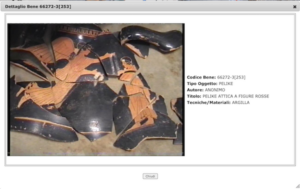
Screenshot from Carabinieri database. Credit Carabinieri TPC.
Another impediment for foreign holders of Italian antiquities who want to know if objects are legitimate is the lack of access to records of past investigations by the Carabinieri. The Carabinieri TPC’s website describes its investigations as based upon “the ‘database of stolen works of art’, [that it describes as] a comprehensive list available to civilians and to foreign police forces alike.” However, although The Carabinieri webpages refer to the INTERPOL “Works of Art” database (which is available to the public) and to its own Carabinieri database for stolen and lost works of art,[13] the public Carabinieri database includes relatively few antiquities, most of them minor.
While the Carabinieri TPC continue to use the thousands of photographs and written descriptions gathered in the Medici, Becchina and other investigations from the 1980s and 1990s to track down and demand objects sold to foreign collectors and museums decades before, Italy still does not allow the public to access this information to identify and clear the market of suspect works. Instead, they will identify a suspect object only when it surfaces in the market or a traveling show.[14]
The slow development of effective Italian enforcement of heritage laws
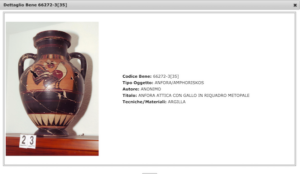
Screenshot of amphora from Carabinieri database. Credit Carabinieri TPC.
Although it is now much improved, Italy had a dismal domestic record for enforcement of its cultural heritage laws throughout most of the 20th century. Many Italian authorities assert that Italy has had enforceable national laws since the enactment of Law no. 364 of 1909[15] (there is a strong counter-argument that the first nationalizing statute was instituted in 1939[16]). In spite of this early legislation, Italian antiquities and archaeological protection laws were often ignored. Literally hundreds of thousands of ‘protected’ objects left Italy after 1909 as a result of Italian authorities’ indifference, willful blindness and (not to put too fine a point on it) widespread petty corruption. If everything covered under the 1909 law – or even the 1939 law – was returned to Italy today, museum collections in the U.S., U.K. and EU would be decimated.
In its 2015 comments on the renewal of the 2000 Italian MOU blocking importation of art from Italy, the Association of Art Museum Directors found poor compliance with its terms:
- Italy’s efforts to protect its cultural patrimony had deteriorated in the last five years. Italy’s cultural budget was slashed one-third between 2009 and 2012. Many structures in Pompeii had collapsed or were on the verge of collapse, and its Great Pompeii Project funded by the European Community, had never gotten off the ground.[17]
- Italy had a domestic market for antiquities that was unavailable to international participants.[18]
- After more than a decade of investigation Italian authorities still refused to release information on known looted objects to museums, but shared it with anti-art trade bloggers, placing museums at risk for accessioning objects without a chance to investigate them.
- Systematic looting and theft persisted in 2015 in Italy. Some 4,000 manuscripts had been stolen from a 16th C library by its director, 2000 artifacts and a major fresco had been stolen from Pompeii, and ongoing highly organized tomb-raiding continued.
- For the prior five years, only U.S. museums that had agreed to restitute important objects to Italy had received long-term loans of archaeological material from Italy.
- Despite a US government-backed indemnity program for foreign museums, Italy required American museums to purchase insurance from Italian companies on loaned Italian objects but offered no protection to US artworks in Italy. Other museum expenses were also abusively high.
Improvements in domestic enforcement but also a transition to claiming art in foreign collections

Gladiator – The True Story – Exhibition Antikenmuseum Basel und Sammlung Ludwig, photo by Ank Kumar, 17 January 2020, CCA-SA 4.0 International license.
By 2020, however, the AAMD noted that Italy had taken far greater control over its domestic art crime.[19] Since 2015, the Carabinieri TPC have done much to turn its prior abysmal record around. Through diligent investigations and enforcement within Italy’s borders, Italy’s Carabinieri police report that they have reduced in-country thefts of cultural heritage by 61% since 2011[20]. Illegal excavations are greatly reduced to only 20 reported in 2019[21]. There were only 40 reported attempts at illegal export in the same year. This is a remarkable success story that shows how effective the Carabinieri TPC can be when domestic enforcement is truly taken seriously.[22]
However, the AAMD pointed out that, having largely quelled illicit looting and illegal sales inside Italy, the Carabinieri TPC were now hunting outside the country. Italian claims now focused on objects in foreign collections that were exported long ago, when Italian laws were often unenforced.
The 2020 statement of the Association of Art Museum Directors on the proposal to extend Italy’s Memorandum of Understanding with the U.S. questioned “whether Italy is deploying its resources to stop the illegal export into third countries or whether the resources are being used to seek restitution of illicitly obtained objects.”[23]
The AAMD also analyzed U.S. public restitutions of objects between 2017 and 2019. Out of a total of ten recent restitutions of objects from Italy, one was a manuscript stolen sometime after 1824, seven artworks were returned that left Italy between 1944 and 1949, one artwork had been exported in 1968, and two restitutions were for objects taken from Italy in 1988 and in the late 1990s.[24]
Multi-national anti-looting and anti-terror operations catch European thieves and illegal metal detectorists
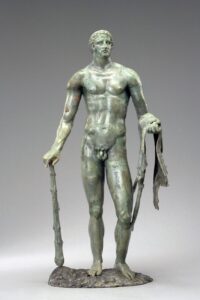
Statuette of standing Hercules, © Antikenmuseum Basel und Sammlung Ludwig, photo by Andreas F. Voegelin.
The 2020 ‘edition’ of the Pandora multinational operation targeting “illicit trafficking of cultural goods” included an Italian Carabinieri component together with law enforcement from 30 other countries. The “highlights” included a French seizure of 27,300 archaeological artefacts from an unmentioned country and possessed by a single individual, 94 stolen ecclesiastical items from a single individual in Spain, a pair of candlesticks stolen 8 years before and a single piece of Swedish folk art, and 6,757 antiquities seized in Greece. The Carabinieri contributed 2,700 ‘cultural goods’ to the haul, including “ceramics, archaeological goods, art and books.” A five-day Cyber Patrol operation in 15 countries looking for suspicious sales online resulted in only 15 new investigations – perhaps the top demonstration to date that Internet sales of antiquities are illusory at best.[25]
The 2020 AAMD testimony on the Italian MOU also noted that there had been large numbers of seizures from group operations involving the Carabinieri and law enforcement from 130 other countries (not including the U.S.), but these numbers and others from similar large scale operations can be deceptive. For example, the total number of objects recovered in Italy and elsewhere by the Carabinieri in 2019 were “857,003 antiquarian, archival, and library items; 84 paleontological items; and 45,717 archaeological items, 23,009 of which are fragmentary items (i.e., sherds) and 14,101 of which are numismatic objects.”[26]) In other words, out of over 900,000 total items recovered by the Carabinieri, in both domestic and massive, joint foreign operations, only 8607 ‘archaeological objects’ that weren’t sherds or coins were found. This means that actual antiquities amounted to less than 1% of the items in allegedly illicit trade.
The Carabinieri should be heartily congratulated on their success in reducing site looting, smuggling, and museum thefts of archaeological materials within Italy. However, these achievements should not encourage the blanket mischaracterization of Italian artifacts outside of Italy as smuggled or looted, the misuse of inter-EU criminal investigative tools, or the treatment of legitimate, good faith owners as criminals. The Belgian and Swiss cases outlined above represent, at best, overreach by Italian police, and at worst, a deliberate abuse of legal authority. The Carabinieri cannot always claim the high moral ground; if they wish to do so, they must hold to a higher standard of transparency, fair dealing, and willingness to engage with international partners in combatting actual crime – by working with rather than hampering lawful collecting, museum exhibitions or the legitimate international art trade.
[1] The ‘Blue Helmets’ Carabinieri component of the Italian Task Force “Unite4Heritage”, was created in 2016 in conjunction with UNESCO. The group was active in Kosovo 2002-2003 and Iraq 2003-2006, and has also worked to secure heritage after manmade and natural disasters in Italy, Croatia and Albania and in Beirut, Lebanon.
[2] Björn Schöpe, translated by Maike Meßmann,“Antikenmuseum Basel comes under fire from the Italian police,” June 17, 2021, https://coinsweekly.com/antikenmuseum-basel-comes-under-fire-from-the-italian-police/
[3] See, Daniel Choice, “Public prosecutor confiscates eleven objects in the Antikenmuseum Basel. BAZ, May 29, 2021, https://www.bazonline.ch/staatsanwaltschaft-beschlagnahmt-elf-objekte-im-antikenmuseum-basel-540063821915
[4] Id.
[5] The Antikenmuseum Basel is only one of several Basel museums now doing provenance research. There has been ongoing work in public collections to identify works associated with Nazi confiscations and forced sales, and recently, the Basel Museum of Cultures has initiated investigations into African objects in it collections, notably twenty objects from Benin acquired around 1899. Altogether, museums in Switzerland hold about 100 objects from Benin. Massimo Agostinis, February 16, 2021, Schweizer Museen untersuchen den Weg afrikanischer Raubkunst, Schweizer Radio und Fernsehen (SRF), https://www.srf.ch/news/schweiz/raubkunst-aus-benin-schweizer-museen-untersuchen-den-weg-afrikanischer-raubkunst.
[6] See note 2 and “Dispute with Italy – Italian police accuse Basel Museum of Antiques of receiving stolen goods,” SRF, June 1, 2021, https://www.srf.ch/news/schweiz/streit-mit-italien-italienische-polizei-wirft-basler-antikenmuseum-hehlerei-vor.
[7] Statement of the Association of Art Museum Directors Concerning the Proposal to Extend the Memorandum of Understanding between the Government of the Republic of Italy and the Government of the United States of America Concerning the Imposition of Import Restrictions on Categories of Archaeological Material Representing the Pre-Classical, Classical and Imperial Roman Periods of Italy, July 22, 2020, Meeting of the Cultural Property Advisory Committee (hereafter “AAMD 2020 Testimony on Italian MOU”) at 7.
[8] Eurojust press release, “Ancient archaeological collection returned to Italy from Belgium with help of Eurojust,” June 21, 2021, https://www.eurojust.europa.eu/ancient-archaeological-collection-returned-italy-belgium-help-eurojust
[9] Media outlets including CNN and The Art Newspaper have unquestioningly characterized the objects in the Belgian collection as “stolen,” parroting the press release by the Carabinieri. CNN also reiterated inaccurate claims about vast increases in global trading of looted artifacts by Katie Paul – despite her data having been debunked by a RAND Corporation study and others. There is no evidence the fine Apulian ceramics in the collection came from such a source. “Hundreds of stolen artifacts recovered in Italy,” CNN, June 22, 2021, https://edition.cnn.com/style/article/museum-stolen-artifacts-italy-scli-intl-scn/index.html.The Art Newspaper also erred in its reporting, stating that the collector was a dealer and that as the objects “could be considered Italian national heritage” their export was plundered and illegal. Ian Mundel, “Hoard of plundered ancient art – discovered by police in a Belgian dealer’s home – is returned to Italy,” The Art Newspaper, June 23, 2021, https://www.theartnewspaper.com/news/archaeological-hoard-confiscated-from-belgian-collector-returned-to-italy.
[10] “Hundreds of stolen artifacts recovered in Italy”, CNN, June 22, 2021, https://edition.cnn.com/style/article/museum-stolen-artifacts-italy-scli-intl-scn/index.html
[11] Raimund Karl, “Protection of cultural property and abuse of rights, Part 1,” Coins Weekly (MünzenWoche), April 23, 2020, https://muenzenwoche.de/kulturgueterschutz-und-rechtsmissbrauch-teil-1/
[12] Id.
[13] The Carabinieri’s Data Bank of illegally stolen cultural assets, established by art. 85 of the Legislative Decree 22 January 2004, n. 42, contains descriptive and photographic information for what it describes as a selection of the most important stolen or illegally exported works. http://tpcweb.carabinieri.it/SitoPubblico/getOpereConfiscate?numPage=1
[14] As the AAMD noted in its 2015 submission on the third renewal of the United States’ MOU with Italy under the Cultural Property Implementation Act: “A recent issue raises concerns about Italy’s commitment to protecting its cultural heritage from illegal transfers on the open market. Specifically, Italy has not made available the dossier of Gianfranco Becchina, a well-known Italian art dealer charged with (although not convicted of) illicit antiquities trafficking. The Becchina dossier is said to be made up of “over 7,400 photographs of relics . . . and 13,000 documents in 140 binders”; in short, meticulous records of Becchina’s dealings that spans his career as an art and antiquities dealer. Swiss authorities discovered the dossier in 2001 and shared it with Italian investigators, yet Italy continues to withhold substantially all of its contents… Beyond the Becchina dossier are “the trove of documents, photographs and objects that Italian investigators have seized from antiquities dealers Edoardo Almagiá, Robin Symes, Robert Hecht, and Giacomo Medici.” Statement of the Association of Art Museum Directors Concerning the Proposed Extension of the Memorandum of Understanding between the Government of the United States of America and the Government of the Republic of Italy Concerning the Imposition of Import Restrictions on Categories of Archaeological Material Representing the Pre-Classical, Classical, and Imperial Roman Periods of Italy, as Amended, Meeting of the Cultural Property Advisory Committee, April 8, 2015, https://aamd.org/sites/default/files/key-issue/FINAL%20AAMD%20PRESENTATION%202015.pdf
[15] Law no. 364/1909 was formed of 42 articles and set out specific provisions covering: the definition of cultural property, which was extended to include any movable and immovable assets marked by historical, archaeological, paleontological or artistic interest, including manuscripts, incunabula, prints, inscriptions and numismatic goods; a general ban on transferring public cultural property belonging to the State and to any other public entities; the pre-emption right in favor of the State in relation to any transfer of cultural property; a compulsory purchase order of cultural property to be issued by the State (at its own discretion) in case of failure by the relevant owner to comply with the restoration obligation of cultural property set forth under Law no. 364/1909. Cecilia Carrara, Marialuisa Garavelli, Sara Colombera for Legance Avvocati Associati, Global Art and Heritage Law Series: Italy and the EU, Committee for Cultural Policy, Inc., at 10-11.
[16] “Law no. 1089/1939 was made up of 73 articles and – even though it failed to provide a clear definition of “goods of artistic and historical interest” and did not provide for the establishment of a central body dedicated to the protections of cultural property – it deserves to be appreciated even to date as it pursued the purpose of balancing the public interest in safeguarding cultural property and the private interest of their relevant owner. In addition, Law no. 1089/1939 has to be considered the key legislative text which has served as a groundwork for the Italian Laws for the protection of the cultural heritage in force to date.” Id. at 11.
[17] In February 2013, Italian police placed former Pompeii restorer Annamaria Caccavi under house arrest on charges of corruption.
[18] Kaywin Feldman, of the Minneapolis Institute of Arts testified that the U.S. government should encourage developed countries, such as Italy, to make redundant antiquities available to the legitimate market as a way to curtail looting, noting that AAMD institutions have not experienced any expedited process or increased availability of export permits and that it was not in the spirit of cooperation to sell antiquities legally within Italy, but then to claim that if these works are sold in another country, they necessarily cause looting.
[19] AAMD 2020 Testimony on Italian MOU at 2-3.
[20] Comando Carabinieri Tutela Patrimonio Culturale, Attivit Operativa (2017), 5,
https://www.beniculturali.it/mibac/multimedia/MiBAC/documents/1545381735727_Attivita_Operativa_2017.pdf (in Italian); Comando Carabinieri Tutela Patrimonio Culturale, Attivit Operativa (2019), 6, 9 & 10.
https://www.beniculturali.it/mibac/multimedia/MiBAC/documents/1589880017803_Attivita_Operativa_2019c.pdf (in Italian).
[21] Comando Carabinieri Tutela Patrimonio Culturale, I Traffici d’arte prima del coronavirus, mentre riaprono i luoghi della cultura, Comunicato Stampa (May 19, 2019), at 6. https://www.beniculturali.it/mibac/multimedia/MiBAC/documents/feed/pdf/Comunicato%20Stampaimported-99458.pdf (in Italian).
[22] Italian authorities have also cooperated with other national forces and Interpol in massive sweeps, searches and seizure of objects for investigation. While the numbers of objects seized in these multi-country campaigns seems staggering, the vast majority of objects seized are either very low value or unsaleable. Operation Demetra, for example resulted in at least forty-one arrests and the seizure of more than 25,000 objects.
[23] AAMD 2020 Testimony on Italian MOU at 4.
[24] Id.
[25] Europol press release, “Over 56,400 Cultural Goods Seized and 67 Arrests in Action Involving 31 Countries,” May 11, 2021, https://www.europol.europa.eu/newsroom/news/over-56-400-cultural-goods-seized-and-67-arrests-in-action-involving-31-countries.
[26] AAMD 2020 Testimony on Italian MOU, at 2, citing to Comando Carabinieri Tutela Patrimonio Culturale, I Traffici d’arte prima del coronavirus, mentre riaprono i luoghi della cultura, Comunicato Stampa (May 19, 2019), https://www.beniculturali.it/mibac/multimedia/MiBAC/documents/feed/pdf/Comunicato%20Stampaimported-99458.pdf (in Italian).
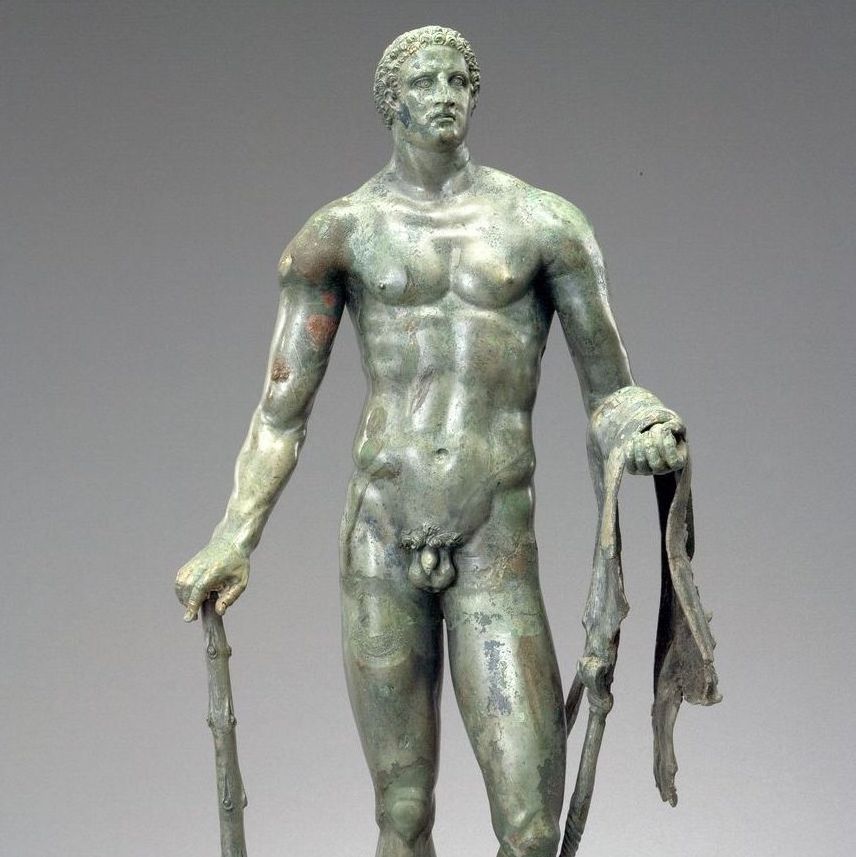 Statuette of standing Hercules, © Antikenmuseum Basel und Sammlung Ludwig, photo by Andreas F. Voegelin, detail.
Statuette of standing Hercules, © Antikenmuseum Basel und Sammlung Ludwig, photo by Andreas F. Voegelin, detail. 

